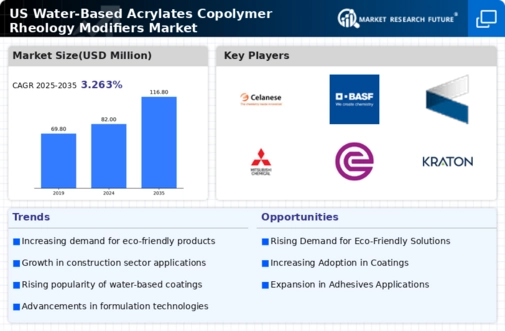The competitive landscape of the US Water-Based Acrylates Copolymer Rheology Modifiers Market is characterized by a dynamic interplay of innovation, technology advancement, and strategic positioning among key players. The market is influenced by various factors such as regulatory frameworks, demand for environmentally friendly solutions, and the increasing focus on product performance in a range of applications including coatings, adhesives, and sealants. Companies operating in this segment are continually seeking to enhance their product offerings while navigating competitive pressures and shifting customer preferences.
The landscape is marked by both established industry leaders and emerging players, all vying for market share through product differentiation and technological superiority. The competitive insights reveal a landscape where product quality, technological capabilities, and customer relationships play pivotal roles in driving market success.In the context of the US Water-Based Acrylates Copolymer Rheology Modifiers Market, Celanese has established itself as a formidable player by leveraging its extensive expertise and focus on innovation. Celanese has concentrated its efforts on developing high-performance products tailored to meet the diverse needs of various applications.
Its robust product portfolio demonstrates a commitment to quality and performance, while the company’s strategic collaborations and partnerships enhance its market visibility and reach. Celanese's emphasis on research and development allows it to remain agile in responding to market demands and trends, positioning the company favorably against its competitors. The cross-functional capabilities of Celanese facilitate the delivery of customized solutions, further reinforcing its competitive edge in the rheology modifiers segment.BASF plays a significant role in the US Water-Based Acrylates Copolymer Rheology Modifiers Market through a diversified approach towards product development and market penetration.
Renowned for its comprehensive product range, BASF offers solutions that cater to a wide spectrum of industrial applications. The company has a strong market presence backed by its investment in research and development, leading to the introduction of innovative products that meet the evolving needs of customers. BASF engages in strategic mergers and acquisitions, which have further bolster its position in the US market by expanding its capabilities and product lines.
The strengths of BASF lie not only in its advanced manufacturing techniques and product quality but also in its commitment to sustainable practices, which align with the growing demand for eco-friendly formulations in the industry. Overall, BASF’s comprehensive approach empowers it to remain a key player in the competitive landscape of rheology modifiers in the US.























Leave a Comment